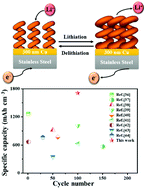Glancing angle deposition of large-scale helical Si@Cu3Si nanorod arrays for high-performance anodes in rechargeable Li-ion batteries†
Abstract
Silicon (Si) anode materials have attracted substantial interest due to their high theoretical capacity. Here, the growth of helical Si@Cu3Si nanorod arrays via glancing angle deposition (GLAD) followed by an annealing process is reported. Pre-deposited Cu atoms were driven into Si-nanorods and successfully reacted with Si to form a Si–Cu alloy at a high temperature. By varying the rotation rate and annealing temperature, the resultant Si@Cu3Si nanorod arrays showed a reasonably accessible surface area with precise control spacing behavior in favor of accommodating Si volume expansion. Meanwhile, the Si@Cu3Si anode materials showed higher electrical conductivity, facilitating Li+ ion diffusion and electron transfer. The Si@Cu3Si nanorod arrays in half cells exhibited a volumetric capacity as high as 3350.1 mA h cm−3 at a rate of 0.25 C and could maintain 1706.7 mA h cm−3 after 100 cycles, which are superior to those of pristine Si materials. This facile and innovative technology provided new insights into the development of Si-based electrode materials.



 Please wait while we load your content...
Please wait while we load your content...